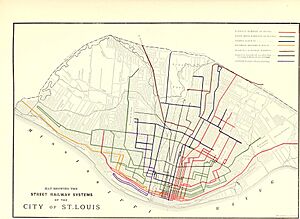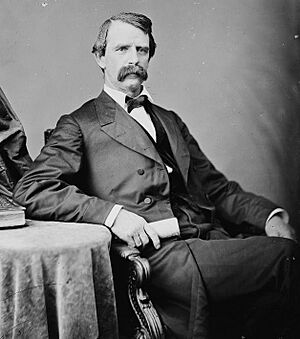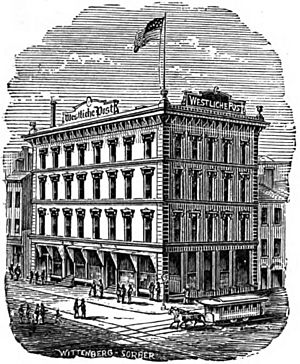Streetcars in St facts for kids
Streetcars were a big part of how people got around in St. Louis, Missouri for over 100 years. They started in the mid-1800s and ran until the early 1960s. At first, many different private companies ran these streetcar lines. But by the 1900s, most of them joined together to form the St. Louis Public Service Company. This company served both St. Louis city and nearby St. Louis County, Missouri. Other companies, like those serving the Metro East area, kept running separately. Starting in the 1930s, streetcar service slowly stopped, and buses took their place.
History of Streetcars
Getting Around Early St. Louis
By the 1830s, St. Louis had grown quite a bit. It was hard for people to walk everywhere they needed to go. In 1843, a man named Erastus Wells started a service with horse-drawn carriages called "omnibuses." These were like early buses. Other companies soon started their own omnibus services. By 1850, most of these companies joined together. They had 90 carriages and many routes around the city. These early horse-drawn lines helped plan where the first streetcar tracks would go.
First Streetcar Lines
In 1855, some people wanted to build a street railway, like those in big eastern cities. The first streetcar line in St. Louis opened on July 4, 1859. It ran on Olive Street. At first, there were problems getting good tracks, and cars often went off the rails. All the early streetcars were pulled by horses. These were called Horsecars.
After the American Civil War, more streetcar lines opened. In 1874, a new line connected St. Louis to East St. Louis, Illinois, across the Eads Bridge. People also started trying out mechanical power for the cars. A steam-powered line opened in 1868. However, this line used different tracks and didn't connect with the horse-drawn lines.
Why Streetcars Disappeared
In the 1920s, motor buses started to replace streetcars. Buses could drive anywhere on public roads, only paying for vehicle and gas taxes. Streetcars, however, had to stay on their tracks. They also had to pay extra taxes for the tracks they put in the road. Even though a good transit route doesn't need to change often, buses seemed more flexible.
The building of Highway I-70 through downtown St. Louis also caused many streetcar lines to close. The very last streetcar route in St. Louis, the 15 Hodiamont line, stopped running on May 21, 1966. Today, many of the old streetcar routes are now used by MetroBus and Madison County Transit bus routes.
Streetcar Builders
The St. Louis Car Company started in 1887. It became the biggest streetcar builder in the world! They built streetcars for cities all over the country and even internationally. The company was located at 3023 North Broadway and stayed open until 1973.
Old Streetcar Lines and Companies
Many different companies and lines operated streetcars in St. Louis over the years. Some of the important ones included:
- Baden and St. Louis Railroad
- Benton and Bellefontaine Railroad
- Citizens Railway
- Cass Avenue and Fairgrounds Railroad
- Forest Park and Clayton Railroad
- Lindell Railroad
- Midland Street Railway
- Missouri Railroad
- Northern Central Railroad
- Peoples Railway Company
- St. Louis and Kirkwood Railway
- St. Louis and Suburban Railway
- St. Louis Railroad
- St. Louis, St. Charles and Western Railway
- St. Louis Public Service Company
- Southern Electric Railway
- Tower Grove and Lafayette Railway Company
- Union Railroad
- Union Depot Railroad
- Belleville Electric Railway Company
- East St. Louis and Suburban Railway Company
- East St. Louis Railway Company
- Illinois Traction Company
- Alton, Jacksonville and Peoria Railway Company
- East St. Louis, Columbia and Waterloo Railway Company
These streetcars served many routes, like the 70 Grand, 20 Cherokee, 10 Delmar, and 15 Hodiamont. The St. Louis Public Service Company even sold some of its streetcars to the San Francisco Municipal Railway in 1957.
Types of Streetcars Used
St. Louis used different types of streetcars. From 1927 to 1951, they ran Peter Witt Streetcars. These were built in the United Railways' shops. Later, they got modern, art-deco style cars called PCC (Presidents Conference Committee) cars. These PCC cars were 46 feet long and 9 feet wide, and they could seat 53 passengers. The St. Louis Car Company built many of these PCC models.
Bringing Streetcars Back
Today, there are three projects trying to bring streetcars back to the St. Louis area!
Delmar Loop Trolley
The Loop Trolley is a special kind of streetcar line called a "heritage trolley." It's about 2.2 miles long and runs in the Delmar Loop area of St. Louis and University City, Missouri. It has 10 stops and connects to places like the Missouri History Museum, Washington University in St. Louis, and two MetroLink train stations.
How the Loop Trolley Started
The Delmar Loop area got its name from a loop of track on the old 10 Delmar Streetcar line. This line stopped running in 1964. A local business owner named Joe Edwards helped make the new trolley line happen. He even bought two old Peter Witt-type streetcars that used to run in Milan, Italy!
Trolley Cars for the Loop
The Loop Trolley uses three different vintage or vintage-style streetcars. Two of them are replicas (copies) of 1903 Brill streetcars. These were bought from Portland, Oregon. The third car is an old 1928 trolley from Melbourne, Australia, which used to run in Seattle. These cars needed some changes, like adding wheelchair lifts, to meet modern rules.
St. Charles City Streetcar
Some of the original 1700 series PCC streetcars from St. Louis were bought for a new development called New Town at St. Charles. Some of these old streetcars will be turned into cool diners, cafes, or bookstores. Others will be fixed up and put back into service on a proposed 8-mile route from New Town to St. Charles, Missouri.
St. Louis Streetcar
In 2013, Forbes magazine wrote about new streetcar systems being built in different U.S. cities. St. Louis is planning to build a 7-mile modern streetcar system. This new system would connect Downtown St. Louis to the Central West End and other neighborhoods like Midtown. It would be a separate system from the Delmar Loop Trolley.




